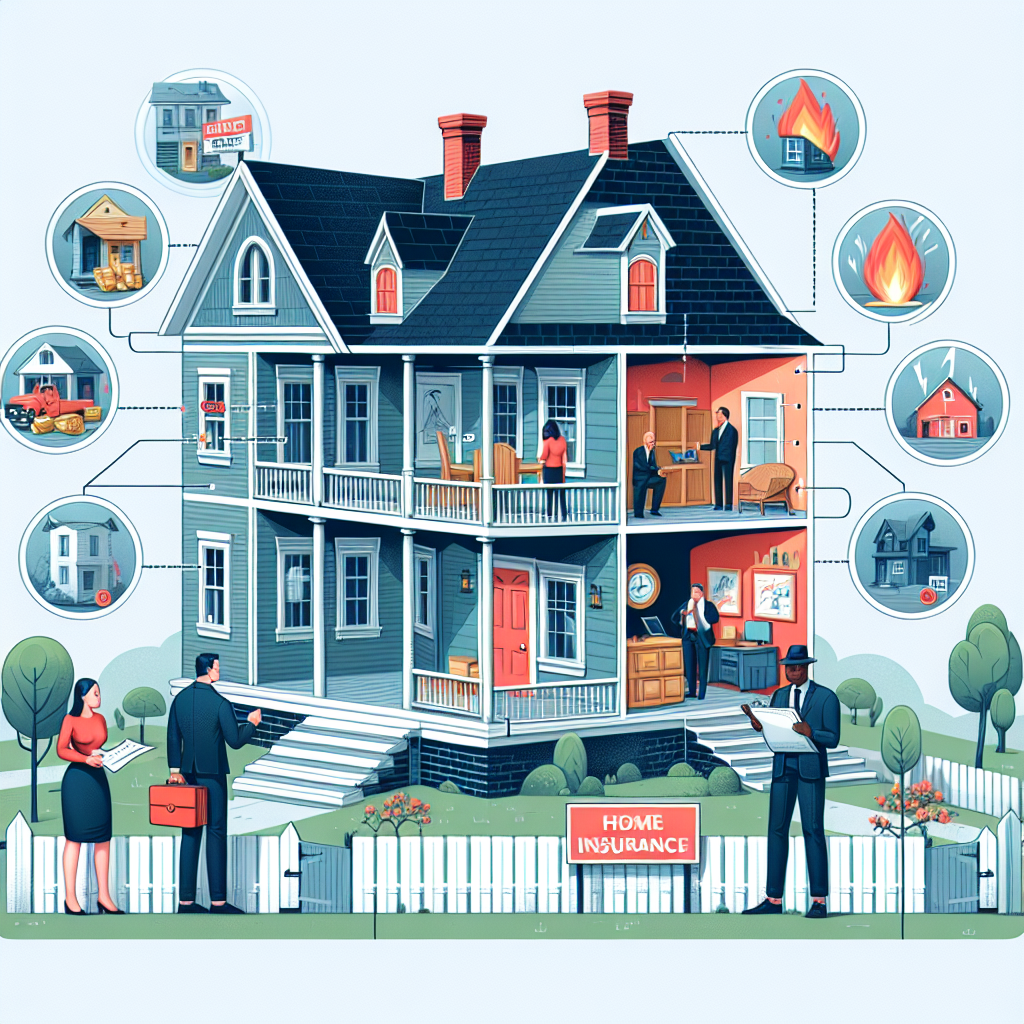-
Table of Contents
- Unveiling Home Insurance: Critical Insights for Investors
- Understanding Home Insurance
- Types of Home Insurance Policies
- Key Components of Home Insurance
- Dwelling Coverage
- Other Structures Coverage
- Personal Property Coverage
- Liability Coverage
- Loss of Use Coverage
- Factors Influencing Home Insurance Premiums
- Location
- Home Characteristics
- Coverage Amount
- Claims History
- Case Studies: Real-World Examples
- Case Study 1: Natural Disaster
- Case Study 2: Liability Claim
- Statistics: The Importance of Home Insurance
- Tips for Investors: Maximizing Home Insurance Benefits
- Conduct Regular Reviews
- Bundle Policies
- Implement Safety Measures
- Shop Around
- Consider Higher Deductibles
- Conclusion
Unveiling Home Insurance: Critical Insights for Investors

Home insurance is a crucial aspect of property investment that often goes underappreciated until disaster strikes. For investors, understanding the intricacies of home insurance can mean the difference between a secure investment and a financial catastrophe. This article delves into the essential elements of home insurance, offering critical insights for investors to make informed decisions.
Understanding Home Insurance
Home insurance, also known as homeowner’s insurance, is a type of property insurance that covers losses and damages to an individual’s house and assets in the home. It also provides liability coverage against accidents in the home or on the property. For investors, this means protection against a variety of risks that could otherwise lead to significant financial losses.
Types of Home Insurance Policies
There are several types of home insurance policies, each offering different levels of coverage:
- HO-1: Basic form policy that covers specific perils such as fire, theft, and vandalism.
- HO-2: Broad form policy that covers all perils in HO-1 plus additional ones like falling objects and water damage from plumbing.
- HO-3: Special form policy that covers all perils except those specifically excluded. This is the most common type of policy.
- HO-4: Tenant’s form policy for renters, covering personal property and liability.
- HO-5: Comprehensive form policy that offers the broadest coverage, including personal property.
- HO-6: Condo form policy for condominium owners, covering personal property and the interior structure.
- HO-7: Mobile home form policy for mobile or manufactured homes.
- HO-8: Older home form policy for homes that don’t meet the standards of other policies, often covering the actual cash value rather than replacement cost.
Key Components of Home Insurance
Understanding the key components of home insurance is essential for investors to ensure they are adequately protected. These components include:
Dwelling Coverage
This covers the physical structure of the home, including walls, roof, and built-in appliances. For investors, ensuring that the dwelling coverage is sufficient to rebuild the property in case of total loss is crucial.
Other Structures Coverage
This covers structures not attached to the main house, such as garages, sheds, and fences. Investors should consider the value of these structures when selecting coverage limits.
Personal Property Coverage
This covers personal belongings inside the home, such as furniture, electronics, and clothing. For rental properties, investors should encourage tenants to obtain renter’s insurance to cover their personal property.
Liability Coverage
This provides protection against legal claims for bodily injury or property damage that occur on the property. High liability limits are advisable for investors to protect against potential lawsuits.
Loss of Use Coverage
This covers additional living expenses if the home becomes uninhabitable due to a covered peril. For rental properties, this can include lost rental income.
Factors Influencing Home Insurance Premiums
Several factors influence the cost of home insurance premiums. Investors should be aware of these factors to manage costs effectively:
Location
The location of the property significantly impacts insurance premiums. Homes in areas prone to natural disasters, such as hurricanes, earthquakes, or floods, typically have higher premiums. Additionally, properties in high-crime areas may also face increased costs.
Home Characteristics
The age, size, and construction materials of the home affect premiums. Older homes or those with outdated electrical and plumbing systems may cost more to insure. Conversely, homes with modern safety features like fire alarms and security systems may qualify for discounts.
Coverage Amount
The amount of coverage selected directly impacts the premium. Higher coverage limits and lower deductibles result in higher premiums. Investors should balance adequate coverage with affordability.
Claims History
A history of frequent claims can lead to higher premiums. Investors should maintain the property well to minimize the risk of claims and consider higher deductibles to reduce premium costs.
Case Studies: Real-World Examples
Examining real-world examples can provide valuable insights into the importance of home insurance for investors:
Case Study 1: Natural Disaster
In 2017, Hurricane Harvey caused widespread devastation in Texas, resulting in over $125 billion in damages. Many homeowners without adequate insurance faced financial ruin. However, those with comprehensive home insurance policies were able to rebuild their homes and recover more quickly. This highlights the importance of selecting policies that cover natural disasters, especially in high-risk areas.
Case Study 2: Liability Claim
In 2019, a landlord in California faced a lawsuit after a tenant slipped and fell on an icy walkway, resulting in severe injuries. The landlord’s home insurance policy included liability coverage, which covered the legal fees and settlement costs. Without this coverage, the landlord would have faced significant out-of-pocket expenses, potentially jeopardizing their investment.
Statistics: The Importance of Home Insurance
Statistics underscore the critical role of home insurance in protecting investments:
- According to the Insurance Information Institute (III), about 1 in 20 insured homes has a claim each year.
- The average homeowner’s insurance premium in the U.S. was $1,211 in 2017, according to the National Association of Insurance Commissioners (NAIC).
- In 2019, the average claim for property damage was $13,687, highlighting the potential financial impact of not having adequate coverage.
- Approximately 85% of homeowners have home insurance, but only 37% of renters have renter’s insurance, according to the III.
Tips for Investors: Maximizing Home Insurance Benefits
Investors can take several steps to maximize the benefits of home insurance:
Conduct Regular Reviews
Regularly review insurance policies to ensure they provide adequate coverage. Property values and replacement costs can change over time, necessitating adjustments to coverage limits.
Bundle Policies
Many insurance companies offer discounts for bundling multiple policies, such as home and auto insurance. Investors with multiple properties can also benefit from multi-policy discounts.
Implement Safety Measures
Installing safety features like smoke detectors, security systems, and fire sprinklers can reduce premiums. Additionally, maintaining the property and addressing potential hazards can prevent claims and keep premiums low.
Shop Around
Insurance premiums can vary significantly between providers. Investors should obtain quotes from multiple insurers to find the best coverage at the most competitive price.
Consider Higher Deductibles
Opting for higher deductibles can lower premiums. Investors should weigh the potential savings against the risk of higher out-of-pocket costs in the event of a claim.
Conclusion
Home insurance is a vital component of property investment, offering protection against a wide range of risks. By understanding the different types of policies, key components of coverage, and factors influencing premiums, investors can make informed decisions to safeguard their investments. Real-world examples and statistics highlight the importance of adequate coverage, while practical tips can help investors maximize the benefits of home insurance. Ultimately, a well-chosen home insurance policy provides peace of mind and financial security, ensuring that investments remain protected in the face of unforeseen events.
In summary, home insurance is not just a regulatory requirement but a strategic tool for investors. By taking a proactive approach to understanding and managing home insurance, investors can protect their assets, minimize risks, and ensure long-term financial stability.








